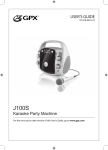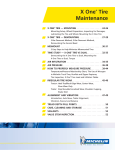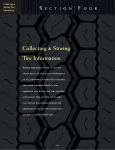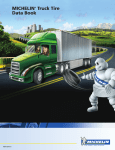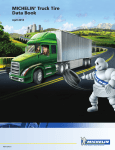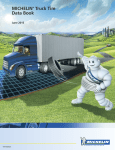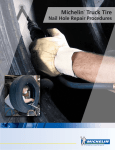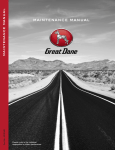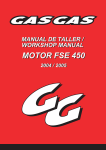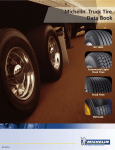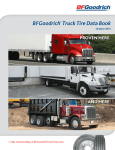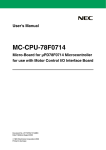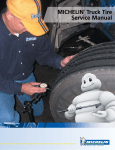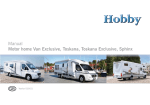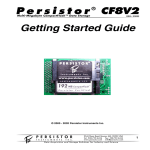Download Retread and Repair Recommendations
Transcript
Retread and Repair Recommendations X ONE RETREAD AND REPAIR RECOMMENDATIONS . . . . . . . . . . . . . . . . . . . . 54 ® Retread Limits Casing Age Limits Initial Inspection Shearography Buffing GENERAL REPAIR GUIDELINES . . . . . . . . . . . . . 55-56 Skiving REPAIR LIMIT SPECIFICATIONS . . . . . . . . . . . . . 57-58 Nail Hole Repairs Section Repairs Spot Repairs X One XZU S Tire Repair Recommendations ® ® Bead Repairs Inner Liner Repairs Builder Enveloping Curing Final Inspection X ONE RETREAD ® AND There are no unusual or special procedures necessary for any modern retread plant in North America to handle the X One casings. There are, however, some equipment changes that may be required to handle the wider tread and casing widths. The information described in this technical guide is the most up to date at the time of this publication. However, the X One product and casings continue to evolve. As new products arrive and are enhanced, updates to this guide may be needed. ® ® REPAIR RECOMMENDATIONS BUFFING An expandable rim width of 14.5 inches is required. The beads of the casing should be lubricated with a fast drying non-petroleum based tire lubricant. Buffing should not start before casing reaches target pressure in the expandable rim as defined by your retread process manufacturer. Recommended minimum inflation pressure is 1.2 bars or 18 psi. Recommended tread width ranges are given below and may vary depending on the type and condition of the X One casing. The X One casing’s finished buffed measured width should follow the same standards as other casings: no more than 2 mm less than the width of the tread to be applied and no more than 8 mm more than the width of the tread to be applied. ® RETREAD LIMITS • Line haul = greater than 150,000 miles per tread life: 1 retread • Regional and P&D = 75,000 to 150,000 miles per tread life: 2 retreads • Severe Service, On/Off Road, Urban, Refuse = less than 75,000 miles per tread life: multiple retreads CASING AGE LIMITS ® 445/50R22.5 • Recommended buff radius is 2000 mm • Recommended buff radius for X One XDA-HT tread rubber is 1600 mm • Target circumference 3055 mm - 3065 mm • Recommended tread widths 375* mm - 390 mm ® Customer or tire manufacturer specifications may have more stringent (shorter life) requirements that must also be met. For Line Haul 7 years 455/55R22.5 For Pickup & Delivery 10 years • Recommended buff radius is 2000 mm • Recommended buff radius for X One XDA-HT tread rubber is 1600 mm • Target circumference 3220 mm - 3230 mm • Recommended tread widths 385* mm - 400 mm ® For Severe Use no age restriction INITIAL INSPECTION Inspect the X One casings as defined by your retread process manufacturer or industry recommended practices using appropriate equipment. When using an electronic liner inspection device, such as the Hawkinson NDT, a new wide base probe of at least 275 mm/10.9 inches is required to help ensure sufficient and consistent cable contact with the shoulder/upper sidewall area. (Hawkinson part # PROBE ASSEMBLY 009). ® SHEAROGRAPHY If using laser shearography inspection, per equipment manufacturer, adjust and or modify to help ensure complete imaging, shoulder to shoulder. 54 ™ ™ * Indicates wing style tread designs. NOTE: For non-Michelin wing tread products, contact MRT, Duncan, SC at 1-888-678-5470, then press 3 for Technical Support. NOTE: Using an improper buff radius or buff width could result in damage to the belt package, irregular tread wear and reduced casing life. Incorrect preparation of the casing for retreading will void the original warranty. GENERAL REPAIR GUIDELINES Recommended quantity limits represent repair guidelines based on the application of the tire in use. General applications listed are Line Haul, Pickup & Delivery, and Severe Use. The performance requirements and usage demands differ for these applications and warrant different repair specifications. If edges of protector ply or 3rd working ply are frayed, they may be skived if total area does not exceed: • 15 mm width on total circumference on one side. • 10 mm width x 200 mm length on the other side. Crown damages up to 15 mm in length must be probed for separation or loose wires. If the area is tight they should not be buzzed out. Certain customers may have more stringent requirement that must be met for their needs. Refer to your customer specific requirements to help ensure that their limits are met as well. Removal to top ply cables: • Maximum area at one point = 20 mm • Maximum points around the casing = 3 Also, economic considerations may limit repairs below the number that is permitted for performance requirements and result in the rejection of casings. Protector Ply Severe Use refers to off-the-road type applications such as waste haulers, cement mixers and logging operations. 3rd Working Ply 2nd Working Ply — Infini-Coil™ 1st Working Ply Pickup & Delivery refers to tires used for local areas only. This category does not include mass transportation, buses, and other people movers. These people mover applications are treated like Line Haul. Bottom Crown Ply Line Haul refers to tires used for highway applications and any application not covered in the two special categories above. SKIVING NOTE: Buzz out limits are increased as outlined below due to the increased surface area of the X One tire over a standard size tire. ® Buzzouts on Crown Suggested Quantity* Depth Diameter/ Surface Line Haul, Pickup & Delivery Severe Use - Protector Ply - 3rd Working Ply Diameter 40 mm or Surface 1600 mm2 15 60 - 2nd Working Ply (Infini-Coil ) - 1st Working Ply - Bottom Crown Ply Diameter 30 mm or Surface 900 mm2 3 20 ™ * Suggested Quantity is a suggested limit only. There is no technical limit as long as the sizes are within specification. However, economic considerations will lead to a practical limit that must be determined by the individual plant manager. 55 Shoulder Shoulder Crown Interior Crown Plies Body Ply Inner Liner Sidewall Sidewall A’ A A’ A 75 mm 75 mm C C 10 mm 10 mm B Bead B Bead NOTE: For truck sizes, point B is located on the point of the bead, point A is found 75 mm from B towards the interior of the casing, and point A is also 75 mm from B but is located on the exterior of the casing. W L W L O Sidewall Damage Crown Damage W L L L L W W L Bead Damage 56 Interior Damage REPAIR LIMIT SPECIFICATIONS Section Repairs are limited to a quantity of 2, sidewall and crown combined. Maximum number of repairs: 5 This is a total number of nail hole and section repairs with no more than 2 section repairs. For example: 3 nail holes + 1 Sidewall Section + 1 Crown Section. For all applications except X One XZU S casings. ® ® For X One XZU S casings use specifications below. ® ® NAIL HOLE REPAIRS Up to 10 mm in diameter in the crown area: 5 NOTE: For best results, nail hole repairs extending into the shoulder area should avoid having the repair reinforcement end in the flex zone of the casing. NOTE: The Michelin X One family has a unique additional belt called Infini-coil . There are no special repair techniques or materials required. ® ® ® SECTION REPAIRS SPOT REPAIRS Crown Area (No damage to body ply cables - rubber repairs only) • Specified limits apply to rubber repairs greater than 2 mm only. Damages less than 2 mm deep are acceptable. Crown Plies Only (Protector Ply and Working Plies) Size: 30 mm diameter Crown Plies and Body Ply (Casing Ply) L 70 mm x W 25 mm, or L 90 mm x W 20 mm, or L 120 mm x W 15 mm SUGGESTED QUANTITY* LxW Sidewall Area DEPTH No limit if Body ply no damage visible to body but not ply cables damaged Body Ply (Casing Ply) L 70 mm x W 25 mm, or L 90 mm x W 20 mm, or L 120 mm x W 15 mm LINE HAUL, PICKUP & DELIVERY SEVERE USE 10 per per sidewall 20 per per sidewall 20 per tire 40 per tire L = Length in radial direction W = Length in circumferential direction * Suggested Quantity is a suggested limit only. There is no technical limit as long as the sizes are within specification. However, economic considerations will lead to a practical limit which must be determined by the individual shop management. X ONE XZU S TIRE REPAIR RECOMMENDATIONS ® ® The X One XZU S tire is optimized for use in sanitation fleets. This usage is defined as a Severe Use Application, therefore, the same repair specs that apply to the other XZU S products also apply to the X One XZU S tire. ® ® ® ® ® Severe Use Application NAIL HOLE REPAIRS 10 mm diameter SIZE SECTION REPAIRS IN THE SIDEWALL AREA L 80 mm W 40 mm or 100 mm or 130 mm 30 mm SECTION REPAIRS IN THE CROWN AREA 40 mm QUANTITY 9 See Note below. 20 mm or 150 mm 1 cable L = Length in radial direction W = Length in circumferential direction Note: Limit for Severe Use represents a total of section and nail hole repairs for both crown and sidewall combined. Refer to radial repair chart to select proper size of repair unit. 57 BEAD REPAIRS BUILDER RUBBER ONLY DAMAGES W MINIMUM DISTANCE BETWEEN REPAIRS QUANTITY ALL APPLICATIONS 150 mm 75 mm 4 per bead 8 per tire • Expandable rim width of 14.5 inches is required. • Tread building should not begin until tire pressure has reached the target inflation pressures in the expandable rim as defined by your retread process manufacturer. • For cushion to casing extruded bonding gum application, recommended minimum inflation pressure is 0.8 bar or 12 psi. RUBBER ONLY DAMAGES EXEMPT FROM REPAIR 445/50R22.5 LOCATION LxW MINIMUM DISTANCE BETWEEN DAMAGES APPLICATION BEAD TOE no damage to bead seat no damage to chafer 2 mm x 50 mm 75 mm SEVERE USE • Recommended base tread widths: 375* mm – 390 mm 455/55R22.5 • Recommended base tread widths: 385* mm – 400 mm * Indicates wing style tread designs. CHAFER STRIP DAMAGES LxW MINIMUM DISTANCE BETWEEN REPAIRS QUANTITY ALL APPLICATIONS 25 mm x 55 mm 75 mm 4 per bead 8 per tire L = Length in radial direction W = Length in circumferential direction NOTE: No repairs to BODY PLY are permitted inside or outside of the tire in the area within a radial direction of 75 mm from the bead point (See area ABA’) Note: For non-Michelin wing tread products, contact MRT Duncan, SC at 1-888-678-5470, then press 3 for Technical Support. ENVELOPING Contact your envelope supplier for the recommended size envelopes to be used. CURING Cure the X One casing according to cure law for the tread design per the retread process manufacturer. ® INNER LINER REPAIRS Blisters which are burst must be repaired. For blisters that are intact: • Height/depth of blister greater than 5 mm must be repaired • Height/depth of blister less than 5 mm should be left intact and not repaired if: - no single blister has an area greater than 30,000 mm2 (45 in2) - the total area of the blisters is not greater than 60,000 mm2 (90 in2) If the size of the blisters is above these limits, then they must be repaired. NOTE: If repairs are excessive, economic considerations may lead to rejection of the casing. 58 FINAL INSPECTION Final inspection of the X One casing according to the retread process manufacturer work method and specifications. ® Operation and Handling OPERATION AND HANDLING . . . . . . . . . . . . . . 60-65 Over-steer Under-steer Hydroplaning Rollover Threshold Jack-Knife Rapid Air Loss Procedure Traction Chains Stopping Distances Limping Home State and Local Regulations HEAT STUDY . . . . . . . . . . . . . . . . . . . . . . . . . . . 66-69 Brake Heat Overview Brake Heat Evaluation: X One tire vs Dual ® OPERATION AND HANDLING OVER-STEER UNDER-STEER Over-steer is when the rear wheels are carving a larger arc than the front wheels or the intended line of the turn. This is often described as a “loose” condition, as the truck feels like the rear end is coming around. Under-steer is when the front wheels are carving a larger arc than the rear wheels. This is often described as “push” or “pushing”, as the front end feels like it is plowing off of a corner. Over-steer: Very difficult to correct Under-steer: Very easy to correct Over-steer is dangerous because once the rear end comes around, the vehicle is uncontrollable and may enter a spin. Braking only makes this condition worse. Under-steer is the more desirable condition because you have direct control over the front tires and deceleration usually corrects the condition. The X One tire has a higher cornering stiffness and can generate more lateral force than standard dual drive tires. Increasing cornering stiffness of the rear tires promotes under-steer. Additionally, it will take more force to jack-knife the vehicle. CORNERING STIFFNESS FOR DIFFERENT TIRES 7,000 Cornering Stiffness (N/Deg) 6,000 5,000 4,000 3,000 2,000 Michelin X One Tire ® 1,000 ® Two dual 0 Conventional Wide-Base 0 5,000 10,000 15,000 20,000 25,000 30,000 40,000 45,000 50,000 Normal Force (N) Source: Recent evaluations at a Michelin facility in South Carolina. 60 HYDROPLANING Hydroplaning occurs when the tire loses contact with the road. This can happen when the water pressure exceeds the contact pressure between the tire and the road. A tire’s contact pressure can reduce your chance of hydroplaning. The X One tire has higher contact pressure at the edge of the tread, which provides a wider “sweet spot” than dual tires. In the graph below, you can see that the contact pressure is slightly higher in the center and significantly higher at the shoulders over dual fitments. Note the drop in contact pressure for dual tires on the graph below. For example, the contact pressure of a dual tire is about 90 psi compared to 116 psi for an X One tire. This will result in the dual tire losing contact with the road at lower speed than the X One tire. This means if hydroplaning occurs at 60 mph for the X One tire, it will occur at 53 mph on the dual. ® ® ® ® Factors that increase likelihood of hydroplaning: – Excess water – Excessive speed – Low tread depth – High tire pressure – Light loads or bob-tailing Contact Pressure Ratio = 90/116 = 88% or 60 mph x 0.88 = 53 mph In other words, if rain is pouring down and water is pooling, the truck’s speed needs to decrease in order to avoid hydroplaning. 1,000 900 Contact Pressure 800 700 600 500 400 300 200 Dual Tires 1 100 Michelin X One Tire ® 0 ® Dual Tires 2 1 3 5 7 9 11 Rib Number Source: Recent evaluations at a Michelin facility in South Carolina. 61 ROLLOVER THRESHOLD 71.5” Track Width There are two things you can change to make a vehicle more resistant to rollover: – Lower the center of gravity – Increase your track width. 0” Offset The X One tire does both, let’s see how. First, the loaded radius of the 445/50R22.5 X One XDA-HT Plus tire is 18.7". A 275/80R22.5 XDA-HT tire (dual equivalent) loaded radius is 19.0". See chart below. For every inch you lower the Center of Gravity, you gain 3 mph additional safety factor with regard to rollover threshold. Second, the track width is measured at the center of where the load is distributed on the ground. For dual, this would be measured at the center of the space between the dual. For the X One tire, it is simply measured from the center of the left side tire to the center of the right side tire. ® ™ 95.6” ™ 74.6” Track Width 2” Offset ® 91.9” As you can see, even though the overall width has reduced, the track width has increased on the X One tire. ® ROLLOVER THRESHOLD WITH TIRE SIZE 0.42 In summary, the X One tire improves rollover threshold by increasing cornering stiffness, increasing track width, and reducing the center of gravity. Rollover Threshold (g) ® These improvements have been validated with: 1) Computer simulation where the whole vehicle is characterized mathematically. 2) Track testing at our internal proving grounds. 3) OE vehicle manufacturers in their independent testing including tilt table testing. 0.40 0.38 0.36 0.34 0.32 275/80R22.5 385/65R22.5 425/65R22.5 445/65R22.5 445/50R22.5 Source: Recent evaluations at a Michelin facility in South Carolina. Specifications for Tread Design: Size Load Range Catalog Number Tread Depth 32nds L 38873 28 445/50R22.5 Max Speed X One XDA-HT ® ™ Loaded Radius PLUS Overall Diameter Overall Width (*) (‡) mph in. mm. in. mm. in. mm. 75 18.7 475 40.5 1028 17.1 435 Approved Rims Revs per Mile 14.00 514 lbs. 10200 Max. Tire Load Single psi kg. kPa 120 830 4625 (1) Comparison based on tractor equipped with 275/80R22.5 Michelin XDA-HT mounted in dual assembly on 8.25x22.5 inch aluminum wheels. ® Specifications for Tread Design: Size 275/80R22.5 62 Max Load Catalog Tread Speed (*) Range Number Depth 32nds mph G 50575 30 75 Loaded Radius in. mm. 19.0 483 ™ XDA-HT ™ Overall Diameter in. mm. High Torque Overall Width (‡) in. 40.8 1036 10.9 Approved Rims mm. 278 8.25, 7.50 Min. Dual Spacing (‡) in. mm. 12.2 311 Revs per Mile 509 Max. Tire Load Single lbs. psi kg. 6175 110 2800 kPa 760 Max. Tire Load Dual lbs. psi kg. 5675 110 2575 kPa 760 JACK-KNIFE When you put the tractor and trailer into an extreme turn or “jack-knife” situation, the trailer is very vulnerable to rollover. Normally, traction has a positive influence on the handling of the truck. This is no longer true when you put a truck in a jack-knife condition. Whether dual or single configuration, you are forcing the tires to stop rolling and slide sideways. As the photo below clearly demonstrates, the trailer is twisting because the tires are holding their position on the road. This can lead to rollover! This is especially true for spread axle trailers and high center of gravity loads. Look at the lateral stress placed on the tires from the jack-knife situation. Turning angles should be minimized to avoid rollover threshold whether operating with duals or X One tires. 63 NEVER exceed vehicle limitations because of improved handling. A tire with a wider footprint is going to provide increased lateral stability when cornering. As a result of this increased lateral stability, the truck will have a tendency to lean less in turns. The increased lateral stability should not equate to increased speed. Always obey posted speed limits on the highways and curves. A good rule of thumb for vehicles with high roll-over thresholds (i.e., tankers, concrete mixers) is to take the curves at the posted limit less 10 mph. RAPID AIR LOSS PROCEDURE Even though the X One tire is an innovative product, it still requires proper air pressure maintenance and visual inspection practices. Tire failure can and will occur. Below you will find a handy reference of the procedure to bring the vehicle to a safe stop following a rapid air loss event: ® Indications: (Some or all of the following may apply.) – No change in handling – Slight lean (depending on wheel position) – Vibrations – Audible noise when rapid air loss occurs Immediate Actions: – Accelerate enough to maintain lane position (DO NOT apply brakes immediately.) – Do not apply maximum brake pressure to bring vehicle to a stop. This stop should be gradual by pumping the brakes. – Creating assembly lock-up can cause irrepairable damage to tire, wheel, axle components, and vehicle. – Pull the vehicle to a safe area. – Do not attempt to limp further down the road. This can be simplified by remembering the following: DROP ROLL and STOP In other words, the vehicle lean or DROP may be the first indication of a rapid air loss. Don’t jam on the brakes! Pumping the brakes will allow the damaged wheel end to ROLL to a STOP without lock-up. There are many Michelin X One tire training videos including rapid air loss handling and specific application demonstrations. To obtain a copy contact your local Michelin dealer or the Michelin sales representative in your area. TRACTION Traction is dependent on the following variables: - speed - tread depth - conditions (dry or wet, depth of water) - tread design - tread rubber compound - road surface (concrete, asphalt) CHAINS Depending on the state in which you are traveling, chains may or may not be required. If chains are required, several companies have chains available for the X One tire. The thing to remember when purchasing chains for your X One tire is the tire size as the 445/50R22.5 chains don’t fit the 455/55R22.5 and vice versa. For more information consult your local dealer or go to www.tirechains.com*. ® ® Secondary Actions: – – – – Turn on flashers Deploy safety triangles Inspect vehicle for damage Call for assistance * The information provided is for reference only. Chains-specific questions should be directed to the chains manufacturer 64 STOPPING DISTANCES Stopping distance with the X One tire is similar to that of dual. A general rule typically mentioned in CDL manuals is to allow one vehicle length or one second between your vehicle and the one you are following for every 10 mph of your velocity. For example: if you are driving at 65 mph, allow 6.5 seconds between your vehicle and the one in front of you. A good way to practice this is to mark a spot, such as a bridge, road sign, etc., that the vehicle you’re following has just passed and count one-one thousand, two-one thousand, etc., to see how long it takes you to reach the same point. If you count to only four-one thousand, then increase your following distance. In wet and/or icy conditions, do not assume that because you have better traction that you will be able to stop quicker. It is always the best practice to increase following distances and reduce driving speeds when traveling in adverse weather conditions. ® LIMPING HOME Limping on the X One tire can cause damage to the wheel and casing. Although the tire is down, it’s possible that it is repairable unless it was run flat. Limping home is never recommended even on dual tires. DOT Regulation 393.75 states: ® The following provides the top ten reasons not to limp home on any tire. 10 TOP REASONS NOT TO LIMP HOME 10. Pavement Damage: when the tire is run to destruction, the wheel contact damages the road. 9. Wheel Damage: $$$ hundreds of dollars. 8. Destroyed Casing: it may have otherwise been repairable. $$$ hundreds of dollars. 7. Cargo Damage: load shifts, collisions, roll-overs or fires. 6. Collateral Truck Damage: fairings, tanks, hoses, brakes, hoods, mudflaps, etc. 5. Wheel and/or Tire Detachment: if the tire/wheel become detached, they become a projectile. 4. Adverse Handling Conditions: mishandled, a runflat could lead to a jack-knife or even a roll-over. 3. Direct D.O.T. Violation: fines and downtime. 2. Creating assembly lock-up can cause irrepairable damage to tire, wheel, axle components, and vehicle. 1. Endangers Other Vehicles and People: heavy duty truck accidents can be fatal. STATE AND LOCAL REGULATIONS Some states have enacted “Load Per Inch Width” regulations for the purpose of governing axle weight on (primarily) the steering axle of commercial vehicles. These regulations provide a carrying capacity of a certain number of pounds per each cross-sectional inch across the tire’s width. The determination of the tire’s width can vary from state to state, but presumably would be based upon either the tire manufacturer's published technical data for overall width, or the width as marked on the sidewall of the tire (which may require conversion from Metric to English units). It is recommended to contact your state’s DOT office to confirm the current “Load Per Inch Width” law. For example, if a state allows for 550 pounds per inch width, a tire marked 445/50R22.5 could carry up to 9,636 pounds (17.52 x 550) or a total of 19,272 pounds on the drive axle (2 x 9636). Another way to look at it is to take the total weight carried, and divide by the stated “Load Per Inch Width” law to determine the appropriate size tire. If a truck needs to carry 16,000 pounds an axle in a state with a 500 pound per inch width limit (16000/500 = 32), you would need a wide single tire that is at least 16 inches wide (32/2). In this case a 445/50R22.5 could legally carry the load (445/25.4 = 17.5 inches Metric to English conversion). The two formulas are: Load per inch width law x tire section width x number of tires = gross axle weight limit Gross axle weight/inch width law/number of tires = minimum tire section width needed State laws and regulations frequently can and do change, so it is recommended that you consult your local State or Province DOT and where you will be traveling to be sure there are no restrictions on the use of the X One tire for your particular operation, equipment and weight. ® 65 HEAT STUDY BRAKE HEAT OVERVIEW Brake temperatures on trucks often reach very high temperatures. Brake drums can reach temperatures of 600° F or more and are in very close proximity to the wheels. This heat can be easily transferred to the wheels and tires. Brake drum heat is transferred to the wheel primarily through radiation and convection. The hot brake drum radiates heat in all directions to the wheel. In addition, the drum heats the air between the drum and the wheel. The heated air rises and transfers additional heat energy to the wheel through convection. Much of the heat is transferred to the wheel in the bead mounting area due to its close proximity to the brake drum. The wheel then directly conducts heat to the tire bead resulting in elevated temperatures in the tire bead area. Excessive bead heat can affect tire life in many truck tire applications. Vehicles in urban and refuse service are most commonly associated with bead heat issues but any application that experiences hard braking can be affected. Results of bead heat: 1) Immediate Failure: In some cases, after periods of hard braking where brake drums reach very high temperature (in excess of 600° F), immediate failure can occur. This normally occurs when a truck is brought to a stop for a period of time with very high brake temperatures. Often this occurs when an over the road truck stops at a truck stop at the bottom of a long descent. As the heat rises from the brake drum there is excessive heat buildup in the portion of the tire bead directly above the brake drum (inner bead of inside dual). The high temperature can cause a breakdown of the rubber products in the bead area and allow the steel body cables to unwrap from the bead. This process results in a tire rapid air loss. This phenomenon is also common in urban and refuse fleets when the driver stops for a break after a period of hard braking. 2) Premature aging of the carcass: Heat is a tire’s worst enemy! A tire subjected to high heat conditions over an extended period of time will experience accelerated aging of the rubber products. The accelerated aging may result in a blowout during operation or it may render the casing unsuitable for retread. The graph below demonstrates how operating with bead temperatures in excess of 200 degrees F will significantly reduce your casing life. Duals - Close to brake drum CASING LIFE vs BEAD TEMPERATURE Bead Temperature (F) 400 350 300 250 200 150 1 10 100 Casing Life (hr) 66 1,000 10,000 Bead damage as a result of brake heat is recognizable in 3 stages of severity. In the first stage, the bead starts to turn inward. This can be visibly identified on the tire when it is dismounted. A straight edge placed across the beads from one bead to the other no longer rests on the bead point, but now rests closer to the bead bearing area. The third stage is when the casing ply fully unwraps from the bead. In extreme cases the casing ply unwraps from the bead all the way around the tire. At this point the tire completely separates from the bead wire. The bead wire can entangle itself around the axle if this type of separation occurs. 3rd stage – partial unwrapping of the casing ply 1st stage - turning of the bead The second stage occurs when the rubber in the bead area starts to split or crack indicating that the steel casing plies are starting to unwrap. 3rd stage – complete unwrapping of the casing ply 2nd stage - bead splitting from heat 67 BRAKE HEAT EVALUATION: X ONE TIRES VS DUALS ® X One tire fitments have greater clearance between the brake drum and the bead of the tire compared to a dual assembly. In addition, due to the 2-inch outset of the wheel for the X One tires, more brake drum is exposed, which provides greater air flow around the drum. These characteristics reduce the heat transfer from the brakes to the tire and allow the brakes to run cooler. This effect was demonstrated on a closed course at the Laurens Proving Grounds, Michelin’s 3000 acre test facility. The Test A 4 x 2 straight truck outfitted with a temperature logging device was loaded to maximum legal limits and operated on a closed course with almost continuous starting and stopping cycles. The truck was brought up to 30 mph and then stopped repeatedly for 45 minutes. The temperature logging device recorded brake drum and wheel temperatures (in the bead area) every 10 seconds. The test was run on both X One tires and duals at similar track temperatures and weather conditions. Exposed brake drum After 45 minutes, when the brakes were at their peak temperature, the temperatures from the data loggers were compared. The brake drums fitted with X One tires were over 100°F cooler and the wheels were over 30°F cooler in the bead area than when equipped with Duals! WHEEL TEMPERATURE X ONE TIRES vs DUALS BRAKE TEMPERATURE X ONE TIRES vs DUALS 220 700 200 600 degrees F degrees F 180 500 400 160 140 300 120 200 100 100 80 Duals Michelin X One Tire ® 68 Source: Recent evaluations at a Michelin facility in South Carolina. Thermal Imaging The thermal image photos were captured after the repeated stopping test followed by 30 minutes of driving without braking. A brake drum temperature advantage for the X One tire of 90 degrees F was still apparent even after the cool down period. It is safe to say that for any given truck, brake ® Duals temperatures on X One tire equipped vehicles will be significantly cooler than brakes on trucks running conventional duals. This effect will be most pronounced during periods of heavy braking but will persist for some time after braking has ended. ® X One tires Source: Recent evaluations at a Michelin facility in South Carolina. 69 70 Appendix ISO LOAD INDEX AND SPEED SYMBOL . . . . . . . . 72 DEFINITIONS . . . . . . . . . . . . . . . . . . . . . . . . . . . 73-74 SPECIAL TOOLS / MOUNTING TOOLS . . . . . . . 75-76 ISO LOAD INDEX 72 AND SPEED SYMBOL LOAD INDEX SPEED SYMBOL The ISO LOAD INDEX is a numerical code associated with the maximum load a tire can carry at the speed indicated by its SPEED SYMBOL under service conditions specified by the tire manufacturer. (1 kg = 2,205 lbs.) The ISO* SPEED SYMBOL indicates the speed at which the tire can carry a load corresponding to its Load Index under service conditions specified by the tire manufacturer. Load Index Kg Lbs 155 3,875 8,540 156 4,000 8,820 157 4,125 9,090 158 4,250 9,370 159 4,375 9,650 160 4,500 9,920 161 4,625 10,200 162 4,750 10,500 163 4,875 10,700 164 5,000 11,000 165 5,150 11,400 166 5,300 11,700 167 5,450 12,000 168 5,600 12,300 169 5,800 12,800 Speed Speed Symbol (kph) mph J K L M N 100 110 120 130 140 62 68 75 81 87 * International Standards Organization Exceeding the lawful speed limit is neither recommended nor endorsed. DEFINITIONS Standard and Low Profile radial truck tire sizes can be more easily understood by breaking down the formula into the three components: the section width in inches or millimeters, aspect ratio and rim/wheel diameter. 1. Tire Size: Standard Size example: 11R22.5 – 11 inch nominal section width, with a height between 90 and 100% of the section width – R = radial – 22.5 wheel diameter Low Profile example: 445/50R22.5 – 445 millimeter nominal section width – 50 is the aspect ratio expressed as a height to width percentage – R = radial – 22.5 wheel diameter 2. Aspect Ratio: A nominal number, which represents the section height, divided by the section width expressed as a percentage. Example 445/50R22.5 Aspect Ratio = 50 3. Rims: The approved/preferred rims is designated for each size tire. Michelin X One tires should only be mounted on the rims shown. ® ® 10. Tire Deflection: Free radius minus the loaded radius. 11. Revolutions Per Mile: Revolutions per mile for a tire size and tread is defined as the number of revolutions that the new tire will make in one mile. Data is normally presented for the loaded tire at its rated load and inflation in the drive position. A tire’s RPM can be determined by measuring, (using SAE J1025) or, estimated by calculating, using a mathematical equation. Michelin Equation: RPM = 20,1681 ⁄ (O.D. - .8d) O.D. = Overall Diameter d = Correction for deflection d = (O.D. ⁄ 2) – SLR SLR = Static Loaded Radius (Michelin Truck Tire Service Manual - MWL40732) At Michelin, Revolutions Per Mile (RPM) are officially determined using the SAE Recommended Practice. The test tires are placed as singles on the drive axle of the test vehicle and set to the corresponding pressure. The vehicle is then driven over a straight 2-mile section at 45 mph while the number of revolutions are counted. (Since speed minimally affects the results for radial tires, other 4. Overall Width: The maximum width (cross section) of the unloaded tires including protruding side ribs and decorations as measured on the preferred rim. Overall width will change 0.1 inch (2.5 mm) for each 1⁄4 inch change in rim width. 4. Overall Width 8. Section Height 5. Overall Diameter: The diameter of the 6. Free Radius unloaded new tire (measured from opposite outer tread surfaces). 3. Rim Width 5. Overall Diameter 6. Free Radius: One-half the overall diameter of the unloaded new tire. 7. Nominal Wheel Diameter: Diameter of rim seat supporting the tire bead given in nearest whole numbers, e.g. 22.5". 7. Nominal Wheel Diameter CL 9. Loaded Radius 8. Section Height: The distance from rim seat to outer tread surface of unloaded tire. 9. Loaded Radius: The distance from the wheel axle centerline to the supporting surface under a tire properly inflated for its load according to the load and inflation tables. 10. Deflection 73 speeds are allowed.) Averaging four runs that are within 1% of each other then derives the RPM measurement. Afterwards, the results are double-checked using shorter distances that are more easily obtained. In addition to these, the test tire is compared to a known baseline tire on a road wheel. This latter method is very accurate and very repeatable when using a similar baseline tire with a known RPM. The SAE procedure recognizes that within the test method itself there will be some variation. In fact there are other factors that cause variation on RPM's among similar tires. Be aware that they will have the same RPM. The SAE procedure determines the RPM to within ± 1.5%. Some factors, which cause variation among tires, are: Load and Pressure – A difference in Load/Pressure could alter the RPM measurement by as much as 1.5%. If pressure is constant, going from an empty vehicle to a fully loaded vehicle can change RPM by 1 to 1.5%. Treadwear – The RPM varies from a new tire to a fully worn tire. This can affect RPM by as much as 3% from the rated RPM. Tread Geometry – The height and stiffness of the blocks and the shape of the tread pattern can affect RPM Torque – The presence of driving and braking torque can affect the RPM. Type and Condition of Pavement – Asphalt vs. concrete, wet vs. dry can create differences in RPM. 74 CALCULATED RPM Example: 445/50R22.5 X One XDA-HT Plus (new tire) ® ™ O.D. SLR d d = = = = 40.5 18.7 (40.5/2) - 18.7 (20.25 - 18.7) = 1.55 RPM = = = = 20,168/((40.5 - (.8 x 1.55)) 20,168/((40.5 - 1.24)) 20,168/39.26 513.7 (Calculated) vs. Data Book (Measured) RPM of 514. RPM All the information required to determine the proper tire size is contained in the application specific data books. To select the proper tire size for a vehicle, it is necessary to know the maximum axle loads that the tires will carry and the maximum continuous speed at which they will operate. The maximum load that a tire can carry is different if it is mounted in single configuration rather than in dual. The allowable axle loads and the required inflation pressures to carry these loads are shown in the charts for both single and dual mountings in the current Michelin Truck Tire Data Book (MWL40731). The maximum allowable continuous speed is also indicated. SPECIAL TOOLS / MOUNTING TOOLS Special tools are available to aid in the mounting and demounting of the X One tire on/off the wheel and the X One assembly on/off the vehicle. Due to the size of the tire and wheel these tools will assist the tire technician in providing both safe and easy methods of removal and installation. When removing any tire from a wheel you should use an Impact Bead Breaker (Slide Hammer) to prevent bead damage. This is also a safer way to dislodge the tire beads from the wheel. ® ® Never strike the beads with a hammer. AFTER YOU MOUNT THE X ONE TIRE ON THE WHEEL YOU MUST CAGE IT ® An extra wide Safety Cage is available for safe inflation of the tire. In most cases a standard cage can accommodate the X One assembly. DOT requires that all truck tires are to be inflated in an Inflation Cage. WARNING! Tire changing can be dangerous, and should be done only by trained personnel using proper tools and equipment as directed by Federal OSHA Standard No. 29 CFR Part 1910.177. Tires may explode during inflation causing injury to operator or bystander. Wear safety goggles. Keep all parts of body outside cage. Use extension hose, clip on chuck, and remote valve. Consult the Michelin Truck Tire Data Book (MWL40732) for proper inflation. ® Impact Bead Breaker (Slide Hammer) 75 TOOLS FOR HANDLING THE X ONE TIRE ASSEMBLY: ® Tire and wheel dollies are available from Commercial Tire Supply Companies to make the mounting and removing of the assemblies on/off of the vehicle easier. There are various types to choose. Some people have difficulty standing on the tire using conventional mounting techniques, and a good device to help “hold” the bead in place without damaging the wheel are coated bead keepers, shown here. Bead Keepers A tire dolly may provide the lifting assistance to mount or remove the X One tire assembly, which may help to avoid possible injury. ® Tire Dolly 76 Index 4 x 2 Tractors................................................................21, 21, 22, 68 6 x 4 Tractors .................................................................................22 Accuride .................................................................................4, 8-10 Air Infiltration..............................................................20, 23, 34, 35 Air Loss................................Inside Cover, 22, 26, 34, 41, 52, 59, 64 Air Pressure ..........Inside Cover, 5, 10, 20, 23, 31, 36-39, 44-47, 64 Alcoa .........................................................................................4, 8-9 Alignment ..........................................................................23, 46-48 Aluminum Wheels....................................1, 4-6, 8-9, 24, 49, 52, 62 Application ..................................Intro, 3-4, 6, 8, 14-15, 21, 38, 46, 55, 57-58, 64, 66, 74 Arvin Meritor...........................................................................12, 14 Axle ...................................Inside Cover, 1, 4, 10-11, 13-14, 18-19, 21-23, 33, 36, 38, 44-48, 63-65, 67, 73 Axle Housing............................................................................13-14 Axle Identification ............................................................11, 13-14 Axle Shaft .......................................................................................13 Axle Skew .................................................................................23, 47 Axle - Drive ........................................................4, 13, 18, 45, 47, 65 Axle - Steer...........................................................................1, 10, 22 Axle - Trailer ...........................................................13-14, 19, 46, 48 Axle - Weight Rating ................................................4, 11, 13-14, 65 Balance ........................................................................23, 30, 47, 49 Bead ......................4, 23-29, 31-32, 34, 43, 53, 56, 58, 66-68, 75-76 Bead Breaking Tool .................................................................27, 75 Bead Damage ..............................................................33, 43, 67, 75 Bead Keepers...........................................................................26, 76 Bead Repair .............................................................................53, 58 Bearing...............................................................................11, 14, 18 Beauty Ring ...................................................................................28 Block Edge Wear......................................................................23, 45 Brake ............................Inside Cover, 7-8, 13, 19, 23, 46, 59, 64-69 Brake Skid Wear.......................................................................23, 46 Brake Heat..........................................................................59, 66-68 Buffing......................................................................................53-54 Builder - Retread Process .......................................................53, 58 Center Wear .............................................................................23, 45 Central Tire Inflation (CTI) ...............................................11, 19-20 Clamping Force...............................................................................8 Chains ......................................................................................59, 64 Circumferential......................................................26, 40, 54, 57-58 Computers...............................................................................11, 18 Contact Pressure ...........................................................................61 Contact Surface Ratio...................................................................36 Contamination..............................................................................51 Corrosion .................................................................5, 40, 45, 57, 58 Curing - Retread Process........................................................53, 58 Dana Spicer .............................................................................13, 14 Demount/Dismount .......................4, 23, 27-29, 32, 34, 43, 67, 75 Differential ....................................................................................13 Dolly.........................................................................................21, 76 DOT .....................................................................................2, 66, 75 Drive Axle...........................................................4, 13, 18, 45, 47, 65 Drop Center.................................................................1, 4, 9, 25, 27 Dual Seal Valve Caps.......................................................................5 Dual/Duals .....................Intro, 2, 4, 6, 13-14, 18-19, 23-24, 32-34, 36-28, 41, 43, 45, 47, 49, 59, 61, 63, 65-66, 68-69, 74 Enveloping-Retread Process ..................................................57, 62 Equivalent Size............................................................................1, 2 Footprint .....................................................Inside Cover, 36-37, 63 Fuel Economy .......................................................................2, 3, 18 Gear(ed).....................................................................................2, 13 GG Ring .........................................................................................33 Gross Axle Weight (GAWR) .................................................4, 14, 65 Gross Vehicle Weight (GVW) ..................................................19, 21 Guide Rib.......................................................................................31 Guidelines....................................................................31, 38, 53, 55 Handling..............................Inside Cover, 22, 37, 39, 59, 63-65, 76 Hayes Lemmerz ........................................................................9, 10 Heel Toe Wear..........................................................................23, 45 Hendrickson..................................................................................14 Hub Pilot......................................................................1, 6, 9, 10, 33 Hydroplaning ..........................................................................59, 61 Inflation ..........Product Specs Disclaimer, 9-11, 19-20, 23-24, 26, 31, 37-41, 43-44, 46, 54, 58, 74-75 Inflation - Central Tire Inflation.......................................11, 19-20 Inflation - Over Inflation ............................................19, 37, 39, 43 Inflation - Under Inflation..........................................Inside Cover Inner Liner .................................................24, 34, 39, 42, 52-53, 58 Inner Liner Repair...................................................................53, 58 Inset ..........................................................................1, 4-5, 9-10, 45 Inspection .....................Inside Cover, 19, 23, 39, 42, 52-54, 58, 64 Inspection - Pre Trip ...............................................................19, 39 Inspection - Retread Process .................................................54, 58 Inspection - Tire Inspection...................................................23, 42 Inspection - Valve Stem ...............................5, 19, 23-24, 26-27, 52 Irregular Wear .............................................23, 31, 38-39, 45-48, 54 Jack-Knife ..........................................................................59, 63, 66 Laurens Proving Grounds ............................................................68 Limping Home ........................................................................59, 65 Load ................Product Specs Disclaimer, 1-2, 5, 9-11, 14, 18, 20, 23, 26, 36-38, 40-41, 44, 61, 63, 65, 68, 71-72, 74 Load Index ...............................................................................71-72 Load Range..............................................................................1, 2, 9 Long Haul/Line Haul ....................................................3, 54-55, 57 Lube, Lubricants, Lubrication ........................18, 24-25, 27, 31, 54 Mismount ..........................................................................23, 31, 49 Missed Nail Hole.....................................................................11, 20 Mount/Mounting .....................4-6, 8-10, 14, 18-19, 23-25, 27-29, 31-34, 43, 48-49, 66-67, 71, 73, 75-76 Mounting Tools .................................................................24, 71, 75 Nail Hole Repair............................................................Intro, 53, 57 Nitrogen...................................................................................23, 39 Offset..............................................................................................13 On/Off Road ........................................................................3, 52-53 O-Rings ......................................................................................5, 24 OSHA............................................................................27, 31, 43, 75 Outset.......................................................1, 4-6, 9-11, 14-15, 17-18 Over Inflation ..............................................................19, 37, 39, 43 Over Load.................................................................................40-41 Over Steer ................................................................................59, 60 Pickup and Delivery .........................................................54, 55, 57 Pressure .....................Inside Cover, 5, 10-11, 19-20, 23-24, 26, 31, 34, 36-42, 44-47, 54, 58, 61, 64, 73-74 77 Index Pressure Gauge.............................................Inside Cover, 5, 39, 41 Pressure Maintenance ............................................5, 20, 38, 39, 64 Pressure Monitoring..........................................................11, 19-20 Pressure Sensors ...............................................................19, 46, 52 Pressure - Cold Inflation Pressure .................10, 19, 38, 39, 40, 44 Radial ..................................Introduction, 19, 45, 47, 49, 57-58, 73 Rapid Air Loss.................................Inside Cover, 22, 34, 40, 59, 64 Ratio .............................................................2, 12, 18, 24, 36, 61, 73 Recreational Vehicle (RV).............................................................21 Refuse Vehicles ............................................................10, 21, 54, 66 Regional Service..................................................................3, 52, 53 Repair ....................................Intro, 24, 34-35, 40, 43, 53-55, 57-58 Repair - Bead Repair...............................................................53, 58 Repair - Inner Liner ................................................................53, 58 Repair - Nail Hole .........................................................Intro, 53, 57 Repair - Section Repair...........................................................53, 57 Repair - Spot Repair................................................................57, 61 Retread....................................Intro, 2, 24, 30, 50-51, 53-54, 58, 66 Retrofit/Retrofitting...............................................1, 2, 6, 15-16, 18 River Wear Only.......................................................................23, 54 Roll-over .......................................................................59, 62-63, 65 Rotate/Rotation ...............................................Inside Cover, 45, 46 RPM ................................................................1, 2, 10, 18, 44, 73-74 Runflat ..............................................................23, 24, 26, 40-42, 65 Runout - Radial and Lateral .......................................23, 30, 47, 49 Safety ........................................19, 24, 26, 31, 33, 43, 50, 62, 64, 75 Safety Cage ........................................................................31, 43, 75 Sealant .....................................................................................23, 52 Section Repair .........................................................................53, 57 Sensors...............................................................................19, 46, 52 Severe Service/Severe Use ..........................................54-55, 57-58 Shearography...........................................................................53-54 Shoulder Step Wear.....................................................23, 30, 38, 46 Sidewall........................Intro, 1, 2, 10, 17, 20, 24, 26, 30-31, 34-35, 38, 40, 41-44, 50-51, 54, 56-57, 65 Skiving......................................................................................53, 55 Specifications ............Intro, Product Specs Disclaimer, 1, 4, 9-11, 15, 31, 44, 48-49, 53-55, 57-58, 62 Specifications - Balance ...............................................................49 Specifications - Repair ............................................................53-58 Specifications - Runout................................................................49 Specifications - Tandem Skew .....................................................51 Specifications - Runflat ................................................................41 Specifications - Toe.......................................................................47 Specifications - Trailer Alignment ...............................................48 Specifications - Wheel...........................................................1, 9-10 Speed Symbol (ISO) ................................................................71-72 Spindle......................................................................4, 11, 13-16, 18 Spot Repair ..............................................................................53, 57 Spread Axle ..............................................................................21, 63 Steel Wheel....................................................1, 4-6, 8-10, 24, 49, 52 Steer Axle .............................................................................1, 10, 22 Stopping Distances .....................................................39, 59, 65, 68 Stud Pilot..........................................................................1, 6-10, 33 T45 Tire Irons ...............................................................24-25, 28-29 Tanker/Tank.................................................................21, 46, 64-65 Technical Bulletin...............................................................Intro, 65 78 Temperature ....................................................19, 23, 39, 66, 68, 69 Temperature Logging Device.......................................................68 Thermal Imaging ..........................................................................69 Tools.......................................................24-25, 29, 47-49, 71, 75-76 Tools - Bead Breaking .......................................................24, 27, 75 Torque......................................1-2, 5, 7-8, 23-24, 33, 45, 52, 62, 74 Track Width ...........................Inside Cover, 4, 11, 13-15, 17, 62, 68 Traction ........................................................3, 13, 37, 50, 59, 63-65 Trailer Axle .............................................................13-14, 19, 46, 48 Tread Act........................................................................................19 Under Inflation .........................................Inside Cover, 19, 24, 38 Under Steer ..............................................................................59-60 Urban .............................................................................3, 52, 54, 66 Valve....................................................1, 5, 29, 23-28, 33, 43, 52, 75 Valve Cap ...................................................................................5, 26 Valve Core................................................................................27, 43 Valve Stem ..............................................5, 19, 23, 24, 26-27, 33, 52 Vibration ................................................................23, 30, 46-47, 49 Wear .................................3, 18, 23, 30-31, 38-39, 45-48, 50, 54, 75 Wear Bars.......................................................................................50 Wear - Block Edge ...................................................................23, 45 Wear - Brake Drag ...................................................................23, 46 Wear - Center ..........................................................................23, 45 Wear - Heel Toe .......................................................................23, 45 Wear - Irregular ..........................................23, 31, 38-39, 45-48, 54 Wear - River .............................................................................23, 54 Wear - Shoulder Step ..................................................23, 30, 38, 46 Wheel.................................Inside Cover, 1, 4-15, 17-19, 22-33, 38, 43-44, 46-47, 49, 64-66, 68, 73-76 X One XDA ...........................................................................2, 3, 36 X One XDA-HT Plus ..........................................2, 3, 36-37, 62, 74 X One XDU ....................................................................................2 X One XTA ..................................................................................2, 3 X One XTE .................................................................................2, 3 X One XZU S ...................................................................2, 3, 53, 57 Zipper Rupture........................................................................40, 42 ® ® ® ™ ® ® ® ® ® ® ® ® Michelin Truck Tire X One Tire Service Manual ® ® To learn more please contact your Michelin Sales Representative or visit www.michelintruck.com To order more books, please call Promotional Fulfillment Center 1-800-677-3322, Option #2 Monday through Friday, 9 a.m. to 6 p.m. Eastern Time MICHELIN NORTH AMERICA, INC., Greenville, South Carolina, USA MICHELIN NORTH AMERICA (CANADA) INC., Laval, Quebec, Canada MICHELIN MEXICO S.A. DE C.V., Querétaro, Mexico An Equal Opportunity Employer Copyright © 2007 MNA, Inc. All rights reserved. MWL43101 (03/07)



























